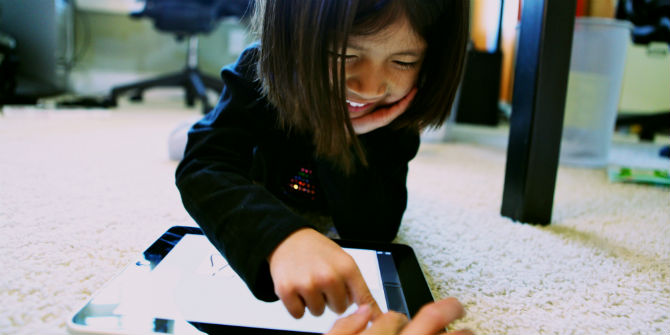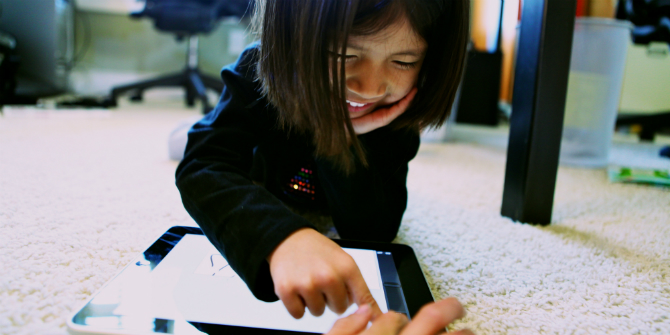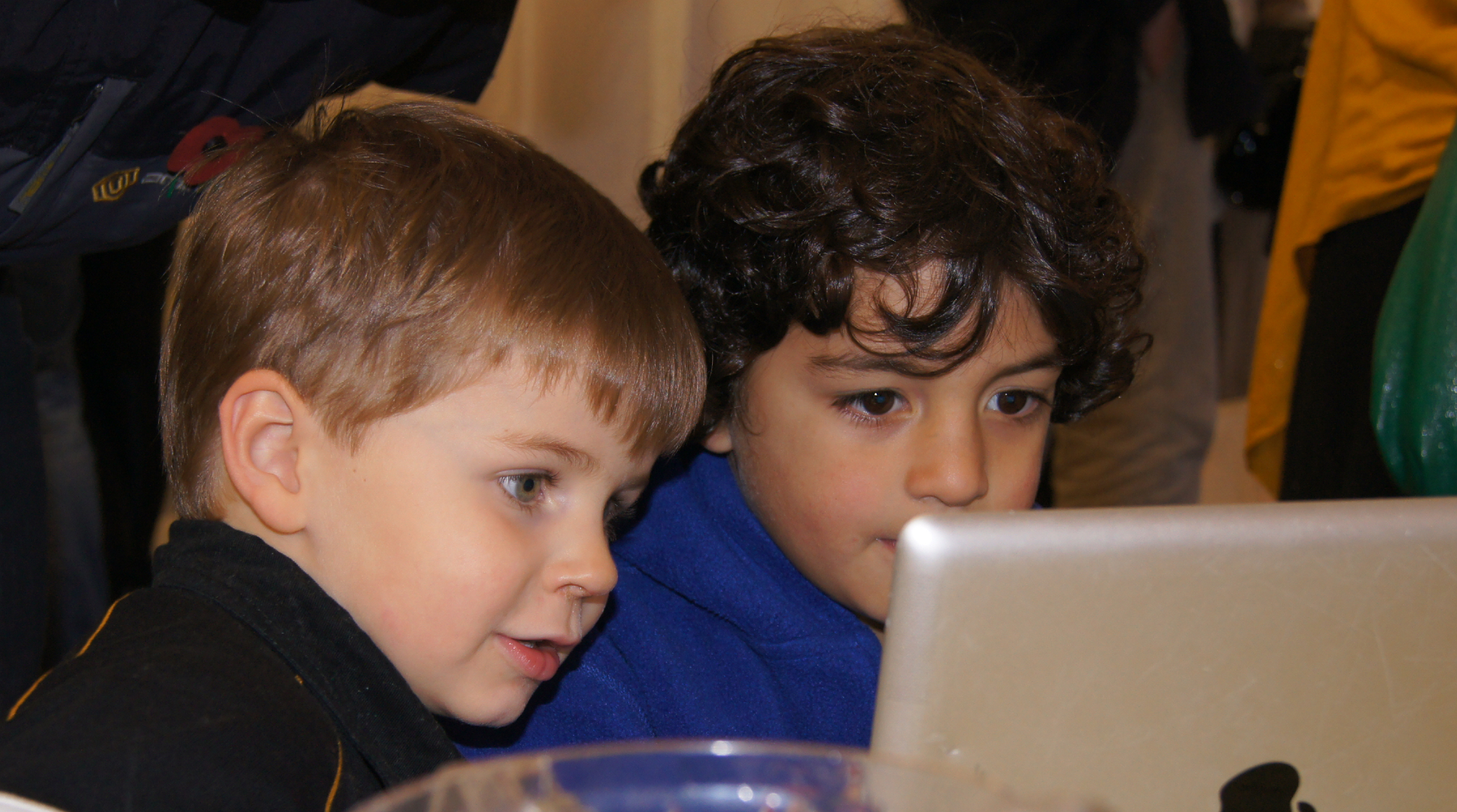 Sonia Livingstone, together with Julian Sefton-Green, followed a class of London teenagers for a year to find out more about how they are, or in some cases are not, connecting online. In this post, Sonia discusses the diverse patterns of media use and digital engagement that counter the common narrative of screens simply dominating teenagers’ lives. The book about this research project, The Class: living and learning in the digital age, just came out. Sonia is Professor of Social Psychology at LSE’s Department of Media and Communications and has more than 25 years of experience in media research with a particular focus on children and young people. She is the lead investigator of the Parenting for a Digital Future research project. [Header image credit: P. Sarkar, CC BY 2.0]
Sonia Livingstone, together with Julian Sefton-Green, followed a class of London teenagers for a year to find out more about how they are, or in some cases are not, connecting online. In this post, Sonia discusses the diverse patterns of media use and digital engagement that counter the common narrative of screens simply dominating teenagers’ lives. The book about this research project, The Class: living and learning in the digital age, just came out. Sonia is Professor of Social Psychology at LSE’s Department of Media and Communications and has more than 25 years of experience in media research with a particular focus on children and young people. She is the lead investigator of the Parenting for a Digital Future research project. [Header image credit: P. Sarkar, CC BY 2.0]
Are young people wholly immersed in their screens, large or small? Pessimistic observers of today’s youth worry that screen time has reached such a point that we should fear for their interactional skills, ability to concentrate, or scope for outside activities. The optimists, however, hope that this is opening up exciting opportunities for new kinds of learning, creating and connecting.
Leisure time media use
In our ethnographic fieldwork with a class of young people aged 13–14, we were curious as to what we would find out about their media activities during leisure time. Who would be proved right, the pessimists or the optimists? National statistics showed that:
- Almost all (97%) of 13- to 14-year-olds had a mobile phone, 84% had a smartphone, and 83% had internet access in their bedroom, although poorer children were much less likely to have access in their bedrooms.
- Most (73%) 13- to 14-year-olds had a social networking profile, three-quarters of them on Facebook (i.e., 55% of all UK 13- to 14-year-olds).
- Among 12- to 15-year-olds, on average around 17 hours a week were spent watching television, another 17 hours on the internet, and 11 hours on gaming, although there is considerable variation around these averages.
- Teenagers do still read, but while nearly three-quarters of 11- to 16-year-olds read paper-based materials, over two-thirds read on a computer, and 59% of 11- to 14-year-olds read on their mobile phone.
Media repertoires
Working in depth with one class gave us a concrete sense of what all of this really means. One day we asked the students how often they did a range of media activities, and then used cluster analysis to identify their ‘media repertoires’:
- A group of boys, mostly from poorer backgrounds, showed the widest media engagement across devices and genres, including much social media, gaming, news, film and more.
- A group of girls, mixed in social class, whose media use was broad although rarely creative, and with little game playing; they liked reading books for leisure
- A group of mixed minority ethnic students, mostly boys, whose generally broad media use included gaming but not so much social media use – they were most likely to do some online content creation.
- A group of middle-class students, mostly boys, engaged with diverse media including news and social media, but less gaming or reading for leisure.
- A demographically mixed group of high media users, whose repertoire included a lot of social media, some gaming and content sharing, but little content creation online.
- One boy on his own rarely used media except books for leisure, preferring to use his computer for homework.
In many ways the class exemplified the national statistics – on a daily basis, most watched television, listened to music, went online for homework and enjoyed using social media. Other media served to divide the class – reading for leisure, watching the news, or playing games.
Optimistic or pessimistic about children’s digital futures
To the pessimists, fearing that screens now dominate teenagers’ lives, I’d note the diverse patterns in the evidence – not all are high social media users, not all love playing games, some enjoy reading books, and some are finding ways to be creative online.
But to the optimists, looking forward to the possibilities for today’s youth as ‘digital natives’, engaging with content created by others, whether professional or user-generated, was far more common than creating and sharing their own content.
Digital activities
We also asked the class about a variety of digital online activities. The only online activity that united the class was going online to find information for homework, although nearly all had played online games at least once in the past month. In terms of creating content, however:
- two-thirds had made their own online playlists to listen to music
- half the class had edited digital photos, and some had also edited videos
- around half had created some content to share online, whether blogging, fiction, podcasts, music, videos, art or games.
While some of the class had done this more than others, it was hard to explain creative uses of digital media in terms of broad demographic patterns – gender, social class or ethnicity. Most of the young people seemed to go through a phase of experimenting a little with one or another way of making or interacting online (beyond the near-universal use of social networking sites). More significantly, for few, if any, did digital media seem to offer a sustained, stimulating and innovative extension to their offline worlds.
Offering constructive support
We heard about quite a few experiments, pursued for a while but then dropped. We could not tell whether they were dropped because of a lack of peer or other social support, or dissatisfaction with the activity and its results, or limitations in terms of technology, skill or other factors. In the young people’s accounts of creative digital activities, parents were generally involved only in making online purchases and, occasionally, in looking up information. And teachers seemed to play little or no role at all. Maybe they did not wish their parents or teachers to be involved in online creative or participatory activities. But also, perhaps parents had not seen that they could play an enabling role in this regard, and that their children might welcome constructive support.






